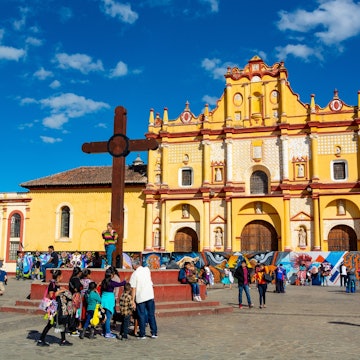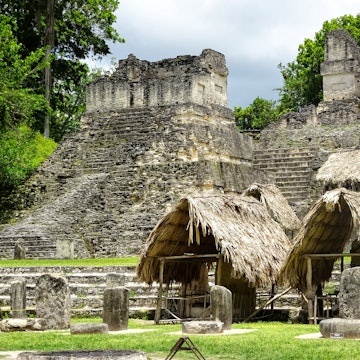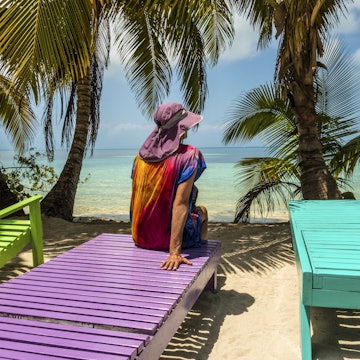

Parque Central by night, Guatemala City. Edwin Remsberg/VWPics/Universal Images Group via Getty Images
There’s an undeniable buzz to Guatemala’s capital that you won’t find elsewhere in the country. Guatemala City is the commercial and political hub of the nation, a sprawling cityscape that sprawls ever more with each passing year. Laid out across a series of plateaus and ravines, the city that’s universally called Guate became the capital back in 1773, after nearby Antigua was razed by an earthquake.
Among Guate’s sea of cement, pavement and traffic congestion are pockets of delight. Parque Central, the main plaza, is ringed by impressive architecture, and the square itself buzzes with life all through the week. The surrounding Zona 1 is busy reinventing itself as a culture and nightlife district, with many abandoned buildings newly inhabited by urban professionals as the inner city comes back to life. And Avenida Las Americas offers a parklike stroll in the midst of the hectic downtown.
Beyond the core of the city, visitors can enjoy stylish districts filled with restaurants and live-music venues, fascinating museums that showcase Guatemala’s rich history and art, and one-of-a-kind cultural sites.
Here are seven ways to get to know Guatemala City.

1. Meander through Zona 1
Make your first stop upon arrival in Guatemala City in the center of its center: Parque Central, in the heart of Zona Uno. On one side is the Palacio Nacional de la Cultura, a stunning building that faces the huge open plaza. Built in the 1930s, it served as the seat of government for decades until it was turned into a museum in 1980. Look out for the indoor traffic lights, installed by a former president to let officials know when movement in the halls was permitted. On the east side of the square sits the Catedral Metropolitana, with an ornate shell and simpler interior. (If time’s short, you can admire it from outside.)
Next, head north to rooftop lounge 5ta Solana to enjoy a cocktail, latte or bite to eat – with a side of fabulous palacio views. Once refreshed, find the northern end of Avenida Sexta (6th Ave). Known simply as La Sexta, this pedestrian-only thoroughfare extends for 10 blocks, with buskers performing tricks, musicians playing for coins and countless small shops, cafes and restaurants. Need racy lingerie from Dubai or hair put in cornrows? Whatever you’re in the market for, it’s here.
Trace your steps back on La Sexta to the northwest corner of the plaza, where you’ll find Cafetería Patsy, a popular spot for coffee and cake. While you should expect lines, the wait is worth it – and you’ll have earned yourself a few tasty calories.
Detour: Train buffs may wish to stop off at the Museo del Ferrocarril, a few blocks from the southern end of La Sexta’s pedestrianized stretch. On display are locomotives and relics, many of them detailing Guatemala’s own (ill-fated) history with railroads.
2. Learn about Maya civilization at the national museum
The Maya civilization is a cornerstone of Guatemalan history and its contemporary life – and one of Guate’s best museums offers a terrific introduction to the culture. In Zona 13 (near the airport), the Museo Nacional de Arqueología y Etnología hosts the country’s largest collection of Maya artifacts, beautifully presented in modern displays. While information in English is sparse, many of the pieces here – particularly the stone sculptures and jewelry collections – are simply amazing to look at with no explanation required.
In particular, look for the stunning stela (stone monument) dedicated to Lady Six Sky of Naranjo and the ornate Throne 1 from Piedras Negras – both spectacular examples of Maya artifacts that were often simultaneously historical, political and artistic. Additional don’t-miss pieces are the jade mask from Tikal, the chocolate vessel from Río Azul, a lovely gold necklace from Iximché, and a variety of pottery, vases and obsidian-flaked items.
Detour: Another top spot to learn about Maya culture, the Museo Popol Vuh explains the myth of Maya creation, the Popol Vuh.

3. Walk through history at Kaminaljuyú
Long before the Spanish arrived, the site of Parque Arqueológico Kaminaljuyú was one of the region’s most important settlements, believed to have dominated much of the highlands. While we’ll never know its full extent since houses have been built over much of the site, what remains is interesting enough, and the parklike setting can make for a nice break from the city’s hustle.
Restoration and excavation work proceeds painstakingly – much of the site has yet to be excavated, and grassy mounds dot the landscape, waiting for someone with the time and money to see what’s underneath. The impressive carvings found here have mostly been moved to museums in town, though you can still get an idea of the scope of the place from what is being uncovered. Scholars estimate that at the settlement’s peak there were thousands of inhabitants and dozens of temples.
Planning tip: Back in town, sit down for a hearty meal of Guatemalan fare at La Cocina de Señora Pu, a family-run favorite that offers up excellent down-home cooking with a couple of modern twists.

4. Take in the entire country at the curious Mapa en Relieve
Tucked away in northern Zona 2, the unusual and highly compelling Mapa en Relieve de Guatemala is exactly what it sounds like: a 3D map of the entire country, laid out in an area a little larger than a swimming pool. Though the colors have faded a bit from sun exposure, and the water pools have cracked and dried, the map is still an impressive overview of the country, with several viewing platforms so you can get a bird’s-eye view. The vertical elevation is presented at 1:2000 scale, turning the country’s many volcanoes into spiky protrusions. Kids love seeing the mountain ranges and valleys in eye-catching 3D.
Planning tip: With three locations in the city and delicious local and international fare, Aida is a great spot for lunch.
5. Sample Guatemala City’s vibrant nightlife
The well-heeled inner-southern suburbs (Zonas 9, 10 and 15) of Guatemala City are a world away from much of the country. You’ll hear plenty of English spoken here – Miami is a favorite holiday destination – and see plenty of brand names, sports cars, fancy shopping malls and other status symbols. This area has long been labeled the Zona Viva, literally the “Alive Zone,” essentially nightlife central. And weekends are when it all heats up.
If you’re on foot, start around the corner of 14a Calle and 2a Av and set out for a wander, listening for the beats to find the party. For folk, jazz and the occasional standup comedy night, Trovajazz has been a cultural center for decades and continues to attract high-quality acts throughout the week.
Once shunned by much of the country after dark, Zona 1 is making a strong comeback in the nightlife arena. The area south of Parque Central has the best concentration of options. Las Cien Puertas, in an alleyway just south of the plaza, has been going forever and forms the center of a cluster of venues playing everything from EDM to thrash metal. Not far away, Rayuela has regular live music and a good dance floor, while Proyecto Poporopo is a cool little gallery/bar/music venue with regular performances.
Local tip: It’s worth noting that after dark the Zona 1 area is still a bit dicey, with many shops completely shuttered after 6pm. Exercise the same caution you would anywhere that’s dark and without many passersby.

6. Admire the civic center’s architecture and art
Much of Guatemala City’s modern architecture is strictly utilitarian – with the major exception of the buildings in Zona 4’s Centro Cívico. Conceived in the 1950s, the complex includes important civic buildings such as the city hall, central bank and high court; leading architects and visual artists of the time collaborated on the design and facades.
Some murals are housed in the building lobbies, and many artworks are visible from the outside, including relief sculptures and mosaics by famous Guatemalan artists such as Dagoberto Vásquez, Carlos Mérida, Roberto González Goyri and Efraín Recinos. Themes range from contemporary Guatemalan life to scenes of the Spanish conquest and episodes from the Popol Vuh (Maya creation story).
Planning tip: If you stick within the same zone, Guatemala City is compact enough to walk. Public transportation is plentiful, though the large red buses aren’t recommended for first-time visitors; use the much safer and more orderly green Transmetro buses instead.

7. Make the trip to see Quiriguá’s Maya ruins and monuments
Quiriguá was once one of the most important cities in the Maya world, with strong connections to Copán in modern-day Honduras (just 50km away). Today, the site – one of Guatemala’s three UNESCO World Heritage–designated places and a 4-hour drive from Guate – is all the more enticing for how unvisited it is. Indeed, get your timing right and you may have the place to yourself (save for an archeologist or two and some groundskeepers). The whole site can be visited in a few hours; it’s not that big, though the level of detail in much of the carving may have you pausing longer than expected.
A couple of temples and a ball court have been unearthed, though the real attractions are the stelae. These monolithic, intricately carved totems of stone scattered around the site record important moments in history, such as the ascension of new kings and large battles. They’re the largest by far of any yet found in the entire known Maya world, and enigma surrounding them has not yet been answered. Why were they built so tall, when others were half or even a third of the size? We don’t have an answer.
Planning tip: The site is also a great spot for nature lovers, with a host of bird species flitting around in the bushes and tall canopy trees. Lazing in the sun on the pathways are tame iguanas (probably looking for food handouts; don’t give in). Poke around under the brush and you might uncover a scorpion or centipede.
This article was adapted from Lonely Planet’s Central America guidebook, published in October 2025.













